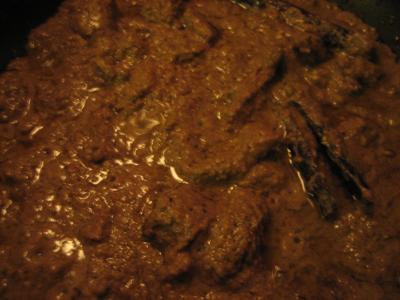Beef Rendang is a delicious dish from Malaysia. It’s kind of a thick stew, like a curry. But it doesn’t contain any curry powder. If you’re one of those strange people who likes the look and mouthfeel of curry but hates the taste of curry powder, this dish is for you! Beef Rendang also doesn’t require a lot of expensive, hard-to-find ingredients or complicated cooking steps. You should be able to find everything for this dish at any grocery store with a good “international” section!

HARDWARE
1 knife
1 cutting board
1 food processor
1 peeler (optional)
1 tall pot (see below)
SOFTWARE:
2 lbs. stew beef
2 tbsp of vegetable oil
2 cinnamon sticks
12 cloves
2 bay leaves
One large (19oz.) can coconut milk (600ml is the goal)
Paste:
6 shallots, peeled and chopped into quarters
2 lemon grass stalks, roughly chopped
2 medium red chilies (see below)
6 garlic cloves peeled
1 two-inch piece of ginger root, peeled and chopped
1 tsp ground ginger
1 tsp ground cumin
1 tsp black pepper
1 tbsp ground coriander
2 tbsp water
1) Put all the “paste” ingredients into a food processor or blender and process until it becomes a paste. I used four of the small Thai chilies available at my local Asian market, however you’ll probably want to use 2-3 (or more, depending on your taste) red jalapeno peppers. They’re for their red color as much as their taste. If it’s not very “paste like” add water a couple of tablespoons at a time until it comes together (but don’t make it too wet).
2) Heat the oil in a pot, pan or wok until it’s smoking hot (you’re gonna stir-fry, so keep that in mind). You’re probably also going to want to use a tall pot for this, as the dish cooks faster uncovered, but tends to splatter while cooking.
3) Add the cinnamon sticks and cloves and stir fry for 1 minute, or until it becomes aromatic.
4) Add the bay leaves and paste and stir fry for 3 minutes.
5) Add the coconut milk and stir well.
6) Add the meat and stir thoroughly.
7) Bring to a strong simmer and cook for 2½ hours, stirring occasionally.
Serve with rice!
This is actually a neat dish to make – the sauce starts off as a pale milk color, but slowly changes to a nice warm brown color. And you can tell it’s getting done when the sauce really starts to thicken up and the meat starts falling apart.









